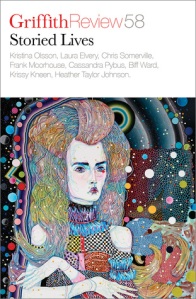
As you know if you read my post about the Word For Word Non-Fiction Festival in Geelong, I spent some of my between-sessions time reading the latest Griffith Review. This is the blurb, which shows why even though this issue is part of the novella project, it was a good choice for idle moments at a Non-Fiction festival:
This month we launch Griffith Review 58: Storied Lives, the stunning fifth edition in the novella project series. Graced by Del Kathryn Barton’s beautiful wild carrot dream, this is a vivid collection of stories about remarkable and reimagined lives. Featuring non-fiction work for the first time, Cassandra Pybus reinterprets Truganini’s harrowing journey across Tasmania, while Frank Moorhouse examines the complex layers of Henry Lawson’s ambivalent masculinity, and Krissy Kneen attempts to trace her family history through her body and DNA. Other stories emerge from the imagination of the writers – Chris Somerville, Kris Olsson, Laura Elvery, Biff Ward and Heather Taylor Johnson – and are brought to life by reading.
 So there is interesting stuff whichever form floats your boat – fiction, non-fiction or creative non-fiction – but for me, the pick of the bunch is Frank Moorhouse’s essay, and yes, as I have already confessed, I couldn’t resist Moorhouse’s new book The Drover’s Wife: A Collection. And this is the blurb for that:
So there is interesting stuff whichever form floats your boat – fiction, non-fiction or creative non-fiction – but for me, the pick of the bunch is Frank Moorhouse’s essay, and yes, as I have already confessed, I couldn’t resist Moorhouse’s new book The Drover’s Wife: A Collection. And this is the blurb for that:
Since Henry Lawson wrote his story ‘The Drover’s Wife’ in 1892, Australian writers, painters, performers and photographers have created a wonderful tradition of drover’s wife works, stories and images.
The Russell Drysdale painting from 1945 extended the mythology and it, too, has become an Australian icon.
Other versions of the Lawson story have been written by Murray Bail, Barbara Jefferis, Mandy Sayer, David Ireland, Madeleine Watts and others, up to the present, including Leah Purcell’s play and Ryan O’Neill’s graphic novel.
In essays and commentary, Frank Moorhouse examines our ongoing fascination with this story and has collected some of the best pieces of writing on the subject. This remarkable, gorgeous book is, he writes, ‘a monument to the drovers’ wives’.
The essay in the Griffith Review, entitled ‘Effeminacy, mateship, love’ is captivating reading because it subverts the masculinist image that we might have of Henry Lawson. Moorhouse puts it like this:
As in the process of the making of all fiction, the author’s personality is backstage. The person ‘Henry Lawson’ as a flawed, hapless man is there with his demons while his imagination strides onstage to take over, forming itself as the storyteller, the narrator, voice of the nation, a persona with a very masculine moustache. In the case of Lawson, the living person backstage has another precarious personality, distinct from the assured writer of strong stories and, sometimes, overwrought, high-flown, drum-beating voice. (p.220)
What Moorhouse finds to his surprise as he analyses ‘Lawson the story’ is that
… Henry Lawson had a precarious sense of his own gender-personality. This is revealed by contemporary descriptions of his personality and manner, and his descriptions of himself (‘sex’ being the anatomical identity of a person and ‘gender’ being the culturally created identity. (p.220)
Moorhouse makes a convincing case, one that shows the contrast between the way that Lawson was viewed in his own time, and in the way that a certain iconic male image of Lawson was fostered. He was often appropriated for other causes, essentially of a strident male culture and an emerging male-dominated nationality. And I think today, when we are all becoming aware that sexuality and gender are much more varied than we knew, this essay is an important contribution. Lawson, our iconic poet, deserves to be known in all his complexity.
In the interests of being honest, there were some stories I did not like in this issue. I thought that the fictionalisation by Cassandra Pybus of the Truganini’s journey in Tasmania with Robinson and Wooreddy was overwrought, and I became tired of the crude language and crude ideas in the piece fictionalising an episode in Van Gogh’s life. But the issue is worth it for the Moorhouse essay about Lawson.
Editor: Julianne Schultz
Title: Storied Lives, Griffith Review #58
Publisher: Text Publishing, 2017
ISBN: 9781925498424
Review copy courtesy of Text Publishing via Brendan Fredericks
Available from Fishpond: Griffith Review 58: The Novella Project V: Storied Lives or subscribe to the Griffith Review here.


I’ll have to buy this just for Moorhouse on Lawson. It has always been clear that Lawson’s most iconic stories reflect his mother, Louisa’s storytelling as much as his own. I just wish I was the one who had thought to say that the way “Lawson” has been appropriated by male literary theorists has applied to the Lawson brand a hyper-masculinity which a close reading of his stories doesn’t really bear out.
LikeLike
By: wadholloway on November 22, 2017
at 12:32 am
Yes… this has made me want to re-read his stories just to see what I think.
Moorhouse’s book looks great: he’s interested in how/why The Drover’s Wife came to be iconic, all those paintings and adaptations and so on… if only I didn’t have so many other books I want to read, (the new Alex Miller, Alexis Wright’s Tracks, Murnane’s Borders, just to name three) I would be reading it right now.
LikeLike
By: Lisa Hill on November 22, 2017
at 9:19 am
[…] Storied Lives, Griffith Review 58, edited by Julianne Schultz […]
LikeLike
By: 2018 NonFiction November: My Year in Nonfiction | ANZ LitLovers LitBlog on November 2, 2018
at 10:41 pm